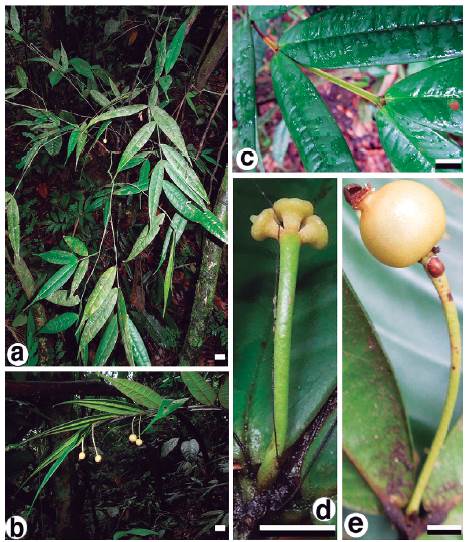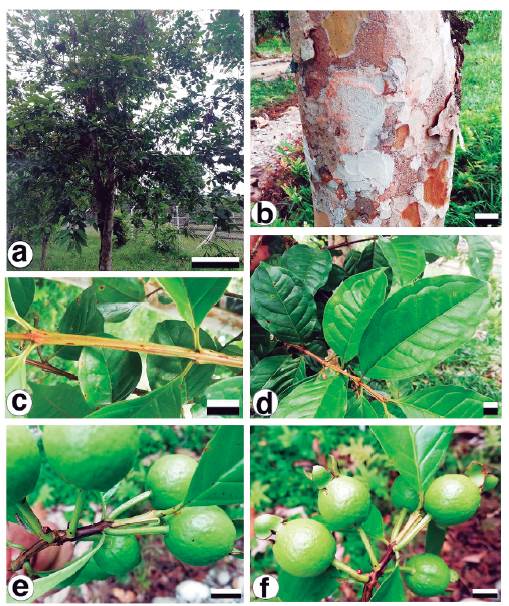During recent explorations on selected areas of Caquetá's Amazonian forest, along with the continuous study of herbarium specimens of Colombian Myrtaceae, two species, one of Myrcia and another of Psidium, previously known only in Brazil, Ecuador, and Peru have been found in Colombia. In this short note, we include comments on the expanded distribution ranges of these species, as well as lists of new collections of these taxa made in the field; voucher specimens of the specimens collected, were deposited in COAH, COL, CUVC, and HUA (acronyms of the herbaria follow Thiers c2019).
Myrcia ishoaquinicca (M. L. Kawas. & B. Holst) A. R. Lourenço & E. Lucas, Phytotaxa 373 (1): 76. 2018. Calyptranthes ishoaquinicca M. L. Kawas. & B. Holst, Sida 21 (4): 1957. 2005 (Fig. 1).

Figure 1 Myrcia ishoaquinicca (M. L. Kawas. & B. Holst) A. R. Lourenço & E. Lucas. a. Habit and habitat, b. twig with infructescences, c. winged young twig, d. Inflorescence with floral buds, e. Infructescence and fruit [a-b, d from Parra-O. et al. 985 (COL), c, e from Parra-O. et al. 983 (COL)]. Scale for a-b = 2 cm, c-e = 5 mm. Photos by Carlos Parra-O.
Comments. Originally described under Calyptranthes, this species was found on lowland and montane forests of Pastaza and Sucumbíos Provinces, Amazonian Region, in Ecuador; it is easily differentiated from other species of Myrcia sect. Calyptranthes by its 4-angled or 4-winged young stems, its discolorous leaf blades, its leaf apex abruptly acuminate with a long acumen of up to 3.5 cm, and its nodding inflorescences (spikes with 1-4 flowers) (Kawasaki and Holst 2005).
In Colombia, Myrcia ishoaquinicca grows in lowland Amazonian forests of Caquetá and Putumayo between 400450 m, sometimes in well-preserved forest with trees of 25-30 m high or in the understory of secondary forests associated with rivers or nearby them. In Amazonian forests near the Fragua river of the Caquetá department, this species is conspicuous among the understory's shrubs or small trees due to its nodding inflorescences and its light-yellow fruits (Fig. 1). The studied Colombian specimens of Myrcia ishoaquinicca expand the range of this species ca. 70 km northeast of its previously known distribution, and they have been collected in ecosystems similar to the ones where the species was originally described. This species was previously thought to be endemic to Ecuador (Kawasaki and Holst 2005). A similar situation was found with Eugenia scalariformis McVaugh. Parra-O. (2013) reported that 93 individuals of Eugenia scalariformis were located in a 25 ha permanent plot in Colombian Amazonia; this species was previously reported as endemic from northeastern Amazonian Peru, and it was categorized as 'VU, Bla' (Vulnerable, severely fragmented or known to exist at no more than ten locations) following UICN criteria (Kawasaki and Holst 2006), mostly based in its supposed narrow distribution range. These findings illustrate the importance of more botanical exploration of the Amazonian region.
Cofán people of Ecuador use Myrcia ishoaquinicca in a ceremony as a purgative (Kawasaki and Holst 2005); it would be interesting to know whether Cofán people of Colombia use this species for this kind of ceremony or not. Studies on plants used by Cofán people in Colombia are scarce, and the few that have been published (e.g., Tobar et al. 2004, Valderrama and Pérez 2004) did not provide detailed lists of the medicinal flora used by such communities in their ceremonies.
Material examined: COLOMBIA. Caquetá: San José del Fragua, "bosque a orilla del río Fragua, vía Balneario Villa Collazos", 1°19'55.0"N, 75°59'5"W; 403 m, 30 jun 2011 (fr), D. Cárdenas et al. 41552 (COAH); San José del Fragua, "vía Balneario Villa Collazos, más adelante del Balneario, reductos de bosque secundario", 01°19'56.0''N, 75°59'05.3''W; 416 m, 01 jun 2018 (bud, fr), C. Parra-O. et al. 983 (COL, COAH, CUVC, HUA), same locality, 01°19'57.1''N, 75°59'05.9''W; 416 m, 01 jun 2018 (fr), C. Parra-O. et al. 984 (COL), same locality, 01°19'56.6''N, 75°59'04.9''W; 417 m, 01 jun 2018 (fr), C. Parra-O. et al. 985 (COL, COAH, HUA). Putumayo: Orito, "resguardo indígena Cañaveral Miraflores, finca Alto Bonito La Esperanza", 0°45'3.9''N, 76°49'13.2''W, 445 m, 22 nov 2013 (fr), W. Rodríguez et al. 8138 (COAH).
Psidium acidum (DC.)Landrum, Brittonia 68 (4): 411. 2016. Psidium acutangulum DC. var. acidum DC., Prodr. 3: 233. 1828. Britoa acida (DC.) O. Berg, Linnaea 27: 436. 1856 (Fig. 2).

Figure 2 Psidium acidum (DC.) Landrum. a. Habit, b. bark, c. winged twig, d. leaves and young branches, e. winged twigs and quadrangular peduncles, f. fruits with calyx remnants [a-f from A. Orejuela & E. Trujillo 3004 (COL)]. Scale for a = 1 m, b = 5 cm, c-f = 1 cm. Photos by Edwin Trujillo.
Comments. One of the specimens examined of this species (Orejuela & Trujillo 3004) was collected in an area used ca. 20 years ago by an Oil Company for growing trees as compensation for its oil extraction activities; it is not clear if all trees that are in the area today were planted by the Company, or if some of them were already in place when the Company began its activities. The area is now an agroforestry demonstrative center where, besides Psidium acidum (four to five trees of ca. 6 m tall), there are trees of Theobroma bicolor Bonpl., Theobroma cacao L., Theobroma grandiflorum (Willd. ex Spreng.) K. Schum., Pourouma cecropiifolia Mart., Inga sp., and Parkia sp. During the collection of this specimen, aboriginal people from nearby areas that were in the center that day informed E. Trujillo that they have trees of this species growing on their land, but they do not plant the trees by themselves; they reported that the plants grow spontaneously in their pastures. They also told him that the ripe fruits are consumed mainly by the children and that they taste a bit sour. If plants are not planted, maybe the seeds of this species are also dispersed by birds or people, as it has been seen for Psidium guajava L.
The specimens of Psidium acidum found in Caquetá and Cauca expand the range of this species ca. 150 km north of its previously known distribution. The presence of Psidium acidum in areas that have been used for cultivation in Colombia agrees with the findings of Landrum (2016), who reported a similar situation in different places in Brazil.
Material examined: COLOMBIA. Caquetá: San José del Fragua, "Resguardo de San Miguel, cerca de la captación de agua para el resguardo de San Miguel", 01°07'51.1''N, 76°15'18.1"W, 342 m, 10 oct 2015 (inm fr), F. Giraldo et al. 3585 (COAH). Cauca: Piamonte, "corregimiento de Miraflor, centro demostrativo agroforestal Guacayaco", 01°01'15.43''N, 76°26'44.98''W, 292 m, 11 ene 2019 (fr), A. Orejuela & E. Trujillo 3004 (COAH, COL, HUA).














